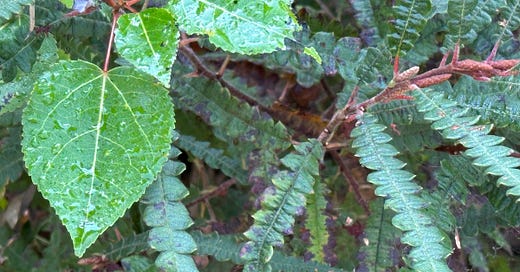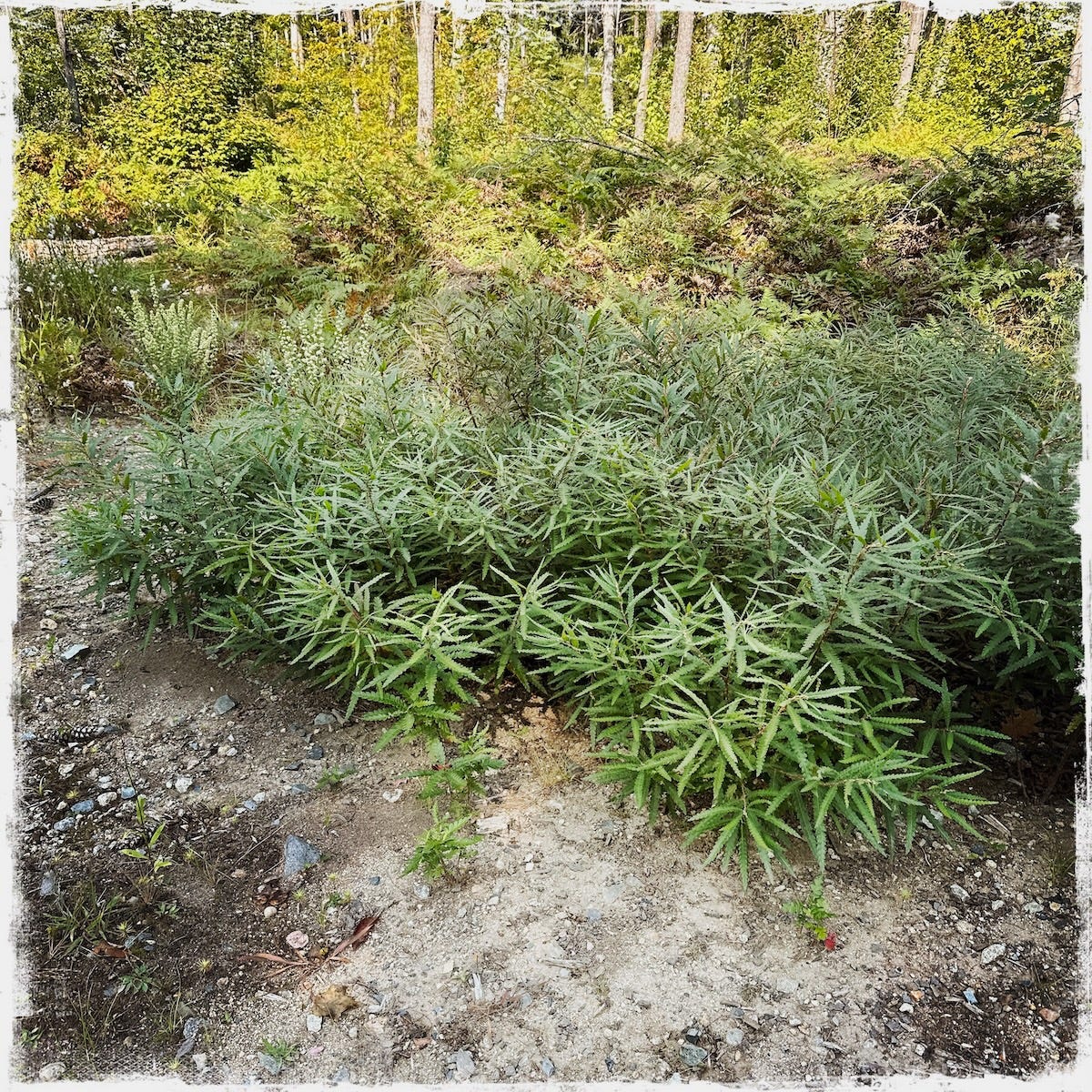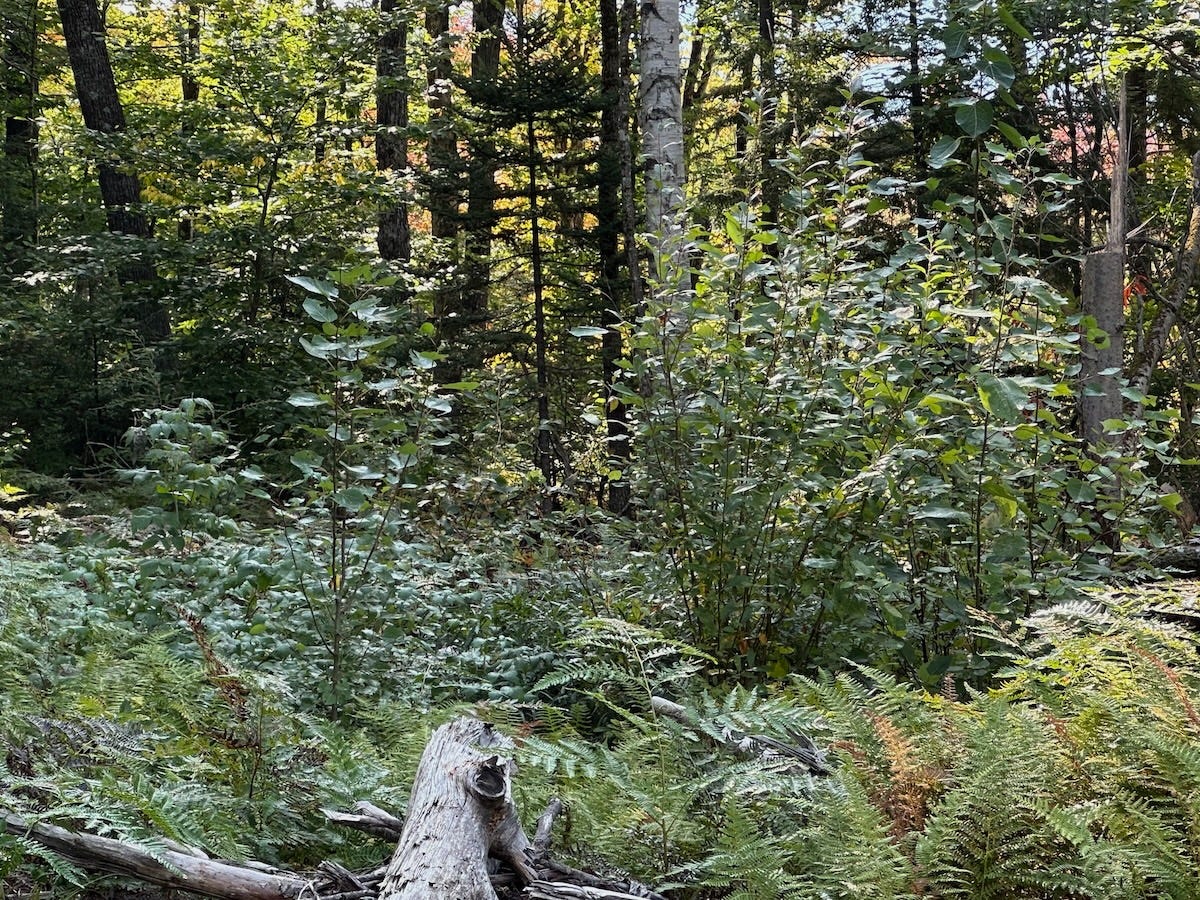Sweetfern Meets the Quaking Poplar
Healing the land and her inhabitants (including me)
I think I’m in love.
With another plant.
Her name is Sweetfern.
Comptonia peregrina: Sweetfern, Sweet-fern, Sweet Fern
But she’s not a fern.
Have you ever heard of her?
Rather than me trying to rattle off botanical facts, I’ll let Blanche tell you a little bit about her:
Sweet fern was one of the most significant plants used by the First Nations people’s in the Eastern Woodlands.
— Aryn Mahood of Sweet Song (click for more information)
Sweet Fern insists upon ample sunlight to grow, forever seeking that magical place where the forest shade gives way to an open clearing of sun rays during the day. The plant flourishes in places where others whither and is quick to colonize land that has been burnt or otherwise destroyed. When crushed, the fern's fronds cascade a surprisingly sweet scent that transports to timelessness.
Sweet Fern Essential Oil was a staple of Native American self-care preparations. Spiritually and energetically, it is used to create a linking bridge between sky and earth. It helps build connections between that which needs to soar and be free and that which needs to stay grounded and stable.
The essence of Sweet Fern benevolently bonds the melodious-molecules between body (earth) and spirit (sky).
When I first moved to this magical little Nature paradise, some clear-cutting was occurring in the woods west of me. I would hear the buzzing of the saws as trees were felled to make space for, I think, new homes.
This continued until one day, it stopped, and I learned that the land had changed hands.
Last year, I tried to walk through the woods in that direction, but so many trees were lying where they had been felled that it was too difficult to get through. So I walked down the road and found a more accessible entrance. It’s private land, but the owners are kind and let me wander with abandon.
A sad energy immediately struck me—a depletion. Desolation. There was a large clearing with logs of all sizes scattered about as if a building site had been abandoned. Which it had, I guess.
So, I did the only thing I could think of—I started to sing. I sang to the trees, the rocks, and the small plants growing in the clearing.
One shrubby plant drew me to her like a magnet. I saw big mounds growing around the perimeter of the clearing. She looked incredibly healthy and strong.
I turned my phone on and took a photo. Later, I identified her as
Sweetfern!
I think I visited up there a few more times, sang my songs, and returned to walking in the woods and sitting by Gone-Away Pond.
And then, this spring and summer, I became obsessed with finding another obvious favorite of mine - the Quaking Poplar.
The Quaking Poplar tree is more commonly called Quaking Aspen. Populus tremuloides, is her Latin name.
If you’re curious about why I call her Quaking Poplar and why this newsletter’s name is The Quaking Poplar, you can revisit my very first post here:
Alas, the only sign of this beloved tree that I’ve seen is of her saplings. They’re here and there on the hill, but they all looked diseased this year.
It wasn’t until the deer flies abated and went to wherever they go (do they die??) that I could start walking in the woods and down the road again.
Again, I wondered, “Where are all the Quaking Poplars??
Since I moved here, I have yet to see a mature one. These woods are a mix of deciduous and evergreen trees, so much of the deciduous leaf cover is too high to identify.
And so, it has been my mission to find one while hiking. I saw more saplings along the path toward the Pond and several tall saplings growing right beside her! That was exciting!
The irony in my excitement does not escape me: if you do an internet search for Quaking Poplar (or Aspen), you will find dozens of articles about how to get rid of them!! Can you believe it? It’s not an easy task because
Adult quaking aspen send out lots of underground runners that sprout "suckers", vigorous young shoots that grow quickly, since they have the advantage of the adult tree's root system to push their growth. This is why you almost always see groves of these "popples", and almost never see a specimen planted alone. They're also brittle, relatively short-lived (40 years), so stands keep themselves going with their numerous runner sprouts.
I first met Poplar at the Blue Deer Center while studying with Eliot Cowan. We had to sit with her, talk with her, draw her, nibble on one of her leaves, and meditate with her. She was part of a grove of medium-sized trees. They seemed feminine and familial to me. Later, our group met with Eliot, and we journeyed to the lower world to meet the spirit of this tree.
I’d forgotten all of this until I had my experience with Jane. And just like that, this tree became an integral part of my Nature family.
A few weeks ago, a friend asked me if I knew the plant, Sweetfern. My brain (and my heart) lit up when I heard her name.
And so, on a beautiful bugless sunny morning last week, I walked down the road and up the hill to where the Sweetfern grows.
And the Quaking Poplars, too!
Because, lo and behold, almost beside every mound of deliciously scented Sweetfern stood at least one (healthy, I might add!) Quaking Poplar!
They are compadres, it seems, healing this land.
The energy felt so much lighter than when I was there last year. Sweetfern surrounds the edges of the clearing, along with lots of other healing survivor plants. Goldenrod and Aster, Birch and “real” Ferns. There are many others that I’ve yet to identify.
I was there early every morning last week before the dew dried. Do you know that dew is more than just a magical backdrop for spider webs?
The idea that dew contains healing powers was echoed in the 1930s by Dr. Edward Bach, an English physician who developed the famed Bach flower remedies. He surmised that the dew sitting upon a blossom absorbed the healing energies of that flower. He reasoned that ingesting a small amount of a flower’s sun-drenched dewdrops could rebalance key emotional energy patterns that were behind many people’s illnesses.
That first morning, I wiped the dewy leaves on my sore hands, the cut on my finger, and my face. Both from Sweetfern and a nearby Quaking Poplar.
Because, guess what? Almost behind every mound of Sweetfern, tall Quaking Poplar saplings happen to be growing!
Are you kidding me???
Here are some Poplars, getting a grove started:
One of my favorite herbalists, Matthew Wood, says this about Populus Tremuloides. Trembling Aspen, Poplar:
Poplar is beneficial in conditions where there is fear, hyperadrenalism, hyperthyroidism, and overactivity of the sympathetic branch. William LeSassier called poplar a remedy for “kidney nervousness.” It has a similar mental state to the Bach flower essence poplar (Populus tremula), used for “fears of unknown origin.”
…it establishes groundedness and strength, in people who are nervous.
— Matthew Wood, “The Earthwise Herbal, Volume II: A Complete Guide to New World Medicinal Plants”
When I read Matthew Wood's words about the trembling/quaking poplar, I can’t help but think about the unbalanced Vata person, especially now that we are transitioning into Vata Season in the Northern Hemisphere.
And this article by Jessy Delleman has some beautiful gems about all Poplar trees.
The different Poplar species have a valuable role in the ecosystem as pioneering plants. Individually, they are relatively short-lived trees that are tenacious in covering disturbed areas. They act to build and stabilize soils, altering the ecosystem to make it more habitable to other successive plant species. There is an adaptability and element of self-sacrifice to these trees that is admirable.
—Jessy Delleman, “Poplar Medicine - From Winter to Spring”
The plants I fall in love with don’t seem to come from a book or a class.
They tend to appear as they say, “When the student is ready, the teacher will appear.”
They are my teachers right now.
My beloved Yarrow whispered her name to me before I even knew who she was.
While wandering the land last week, I noticed many beautiful rocks that kept drawing me to them. I took a photo of one and later identified it as Sandstone. Guess what it had to say?!
Sandstone is often used in meditation to activate the Sacral chakra and help clear the mind and facilitate better decision-making skills. Many people believe it helps inspire creativity and spiritual enlightenment. Place it in the home to encourage balance and harmony within.
Well, how amazing is that? So, in addition to these plants healing the land and those who venture onto it, the rocks are doing the same!
The bears surely know this because there was fresh scat (AKA poop) in the middle of the clearing.
There are lots of chattering chipmunks and singing birds, too.
What felt sad and damaged last year now feels alive, healthy, and thriving.
On the afternoon of the last full moon/partial lunar eclipse - a doozy! I was walking home down the road, and the name Sweet Fern Hill popped into my head. Just then, I heard a wolf howling! I wish it really were a wolf, but it was my phone. Even though it was on Airplane Mode, my moon app was reminding me that the full moon was in 12 hours. Every single time the wolf howls, I jump! But I love it. :)
The following day, I was awakened by an intense dream AND a coyote howling outside. That was real.
While writing this post, I’m sipping a cup of Quaking Poplar and Sweetfern tea from the leaves I picked this morning. Although Sweetfern has a gentle taste, and I added a touch of honey, Quaking Poplar is very bitter.
If you're interested, here are some of the physical health benefits of Poplar tea. Bless the internet for still allowing us to find information like this. If you know what I mean…
The more I meet and greet the plants who call to me, the less I seem to care about harvesting them and making medicine from them. I did harvest a few bunches of Sweetfern to dry for tea, and I made a witch hazel infusion for bug bites and such.
I like to sit with them. If we listen deeply, they have so much to teach us. Thank them for the medicine they give us just by being there. Of course, we can do both…sit with them and drink their tea, which I’m doing right now. Wow, this is bitter!
Maybe Sweetfern can teach us about boundaries, as she tends to grow on the edge of clearings - something sensitive folks who vibrate like the Quaking Poplar need to be mindful of. Everywhere I see them growing together, the Poplars are behind Sweetfern.
She’s a soft, gentle shrub unaffected by bugs ravaging many other plants.
I’m just musing here…thinking as I type.
Almost every time I write one of these posts about my Nature wanderings, the thought always crosses my mind that so much serious stuff is happening in the world. Shouldn’t I be writing more about that?
And then my fellow Nature-lover/writer friend, Amanda at
sent me this:And I think, “Well, ok. If it was good enough for Mary Oliver, it’s good enough for me.”
I just realized that today is the Autumn Equinox. I guess I should have written something about it. But there are no “should haves” allowed here. I’m sure many good posts are out there today, ushering in my favorite time of the year.
Much Love,
Barbara
P.S. Here’s a gem of a song from Humbird
Song for the Seeds
Oh bluebell, do tell
I’m listening and I mean well
Even monsters like their flowers
You watch them fall
From their towers
Through the cracks one seed at a time
I give back what was never mine
Yarrow, what of tomorrow?
Teach me to heal my sorrow
Set the boundary, soft and loving
Clean the wounds of each day
For mending
Through the cracks one seed at a time
I give back what was never mine
Clover, I step over
Takes water from the sky and sows her
No more lawns, I will lay you down
Learn to be patient and spread it out
Through the cracks one seed at a time
I give back what was never mine
Through the cracks one seed at a time
I give back what was never mine
Oh cosmo, where do we go
It’s big out there and so hard to know
What it means, but you’re out there dancing
Could it be as simple as catching the breeze?
Through the cracks one seed at a time
I give back what was never mine
Through the cracks one seed at a time
I give back what was never mine
Through the cracks one seed at a time
I give back what was never mine
Through the cracks one seed at a time
I give back what was never mine
Thank you for your heartfelt comments, your subscriptions (free or paid), or just for stopping by and reading or listening to The Quaking Poplar 🌳!














You and Mary Oliver are doing essential work, Barbara! Thank you for this walk in the woods with you, and for the wisdom shared.
I can hardly believe the synchronicity of this: "Sweetfern Essential Oil...is used to create a linking bridge between sky and earth. It helps build connections between that which needs to soar and be free and that which needs to stay grounded and stable." I know this is not a new concept, but I keep getting in my meditations lately that our role as human souls is exactly that: bridging sky and earth. I'm so curious about the oil; I might order some to see its effects. Have you ever tried it?
And I just have to tell you that my dear friend Jen in WA, the permaculturist, is also a "threshold singer." When you described singing to the clear-cut forest, my eyes filled, remembering how Jen grieved a clear cutting right next to her land. My guess is that she sang, too.
Gosh I loved reading this. Thank you, friend. xox
This is so beautiful! Thank you for sharing all of your wisdom. I recently read that the morning dew on plants is a flower essence. I imagine sitting with the sweet fern and poplar saplings is so deeply healing. Thank you for doing the timeless work of being in relationship with nature and translating those gentle ways to the rest of us.